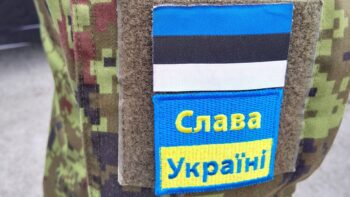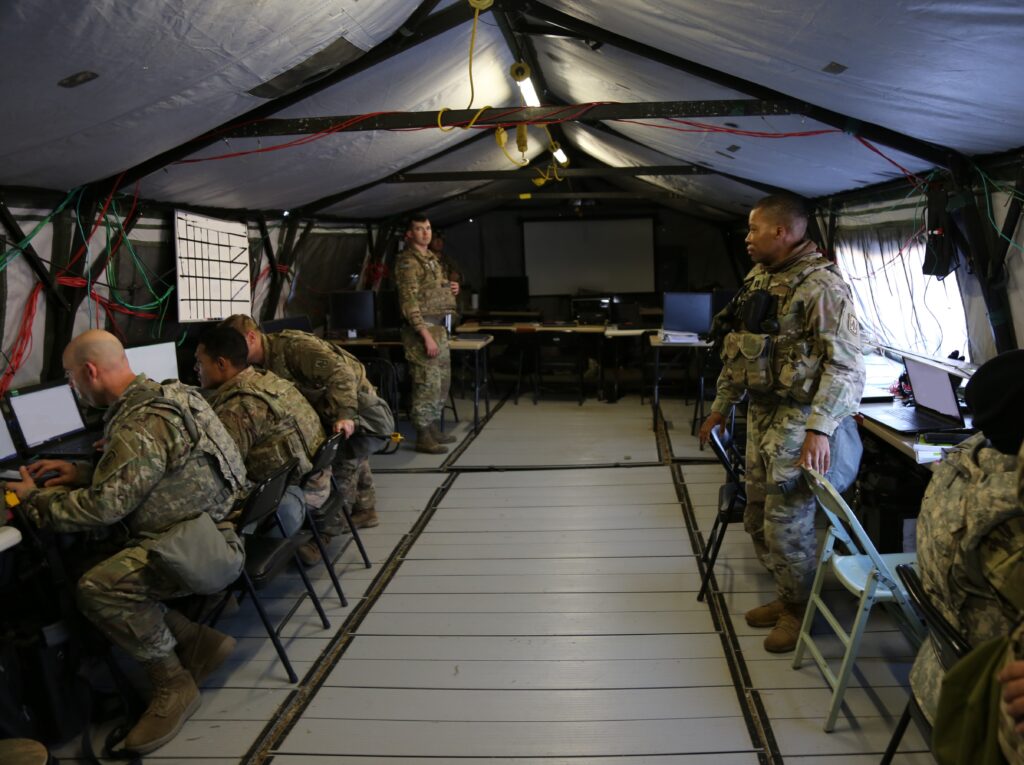
Army soldiers run a field communications center during an exercise.
WASHINGTON: Robotic mini-tanks. High-speed scout aircraft. High-powered jammers. Long-range artillery. More than 16,000 simulated troops and 13 locations. Last month’s Unified Challenge wargame modeled a host of current future Army weapons, but the 400 human players found one thing painfully lacking: a real-time digital picture that could track their fast-moving, far-flung forces over the land, air, cyberspace, and the airwaves.
As the Army hastens to turn its nascent concept for future conflict, Multi-Domain Operations, into a real-life way of war, it urgently needs a command system that can keep up with the complexity. It was actually the Air Force that figured this out first: They’ve been focused on Multi-Domain Command & Control (MDC2) as the critical piece of the problem from the start. But the two services are collaborating closely — there was a sizable Air Force contingent playing in Unified Challenge — and the Army is increasingly convinced MDC2 is critical.
The problem is that Multi-Domain Command & Control isn’t even a formal development program yet, let alone a working system you can try out in an exercise. That means, so far, “we’re using current mission command systems for future weapons systems,” said Chris Willis, modeling and simulations chief for the Maneuver Battle Lab at Fort Benning, Ga. What the Army needs, he told reporters, is a more sophisticated and powerful Common Operational Picture (COP) that can show commanders and their staffs what’s happening in real time over longer distances, at a faster pace, and in more domains.
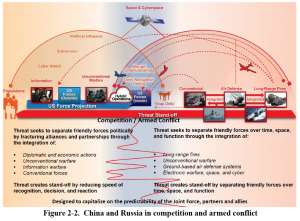
SOURCE: Army Multi-Domain Operations Concept, December 2018.
“There’s just too much going on and it’s happening too fast,” agreed Col. Mark Bailey, head of Army Futures Command’s Joint & Army Experimentation Division (JAED), which orchestrated the exercise.
But the fix isn’t just new software, Bailey said. It will take new thinking. “Leaders must have a cognitive understanding of the operational environment. It’s not just seeing something [on a display],” he said. “It needs to be in your head rather than on a screen in front of you.”
“We need to take a hard look at…how we train leaders to plan and execute…multi-domain operations,” agreed Col. Chris Cassibry director of concepts development at Fort Benning, home of the armor, cavalry and infantry branches. That said, Cassibry argued, the human players in Unified Challenge — mostly Army, but with a significant Air Force contingent as well — did a remarkable job of adapting over the two weeks of the wargame.
“It was a learning process,” Cassibry said. From Day 1 to Day 13, “the speed, the agility at which they moved and the operated was very different. The commanders and the staffs that we had here were really impressive,” he continued. “They rapidly learned how to plan, coordinate, synchronize, all the different tools that we provided.”
“By probably the second week,” Willis added, “they had created their own tools, [digital] products that we kept” for future use. But those improvised, short-term software fixes are no substitute for a new command-and-control system purpose-built for the new way of war.
Ultimately, the military is looking at artificial intelligence (AI) to help commanders and staffs make sense of masses of information quickly — but that wasn’t ready to go in this simulation. Said Willis, “it is extremely difficult to simulate AI without the AI itself.”
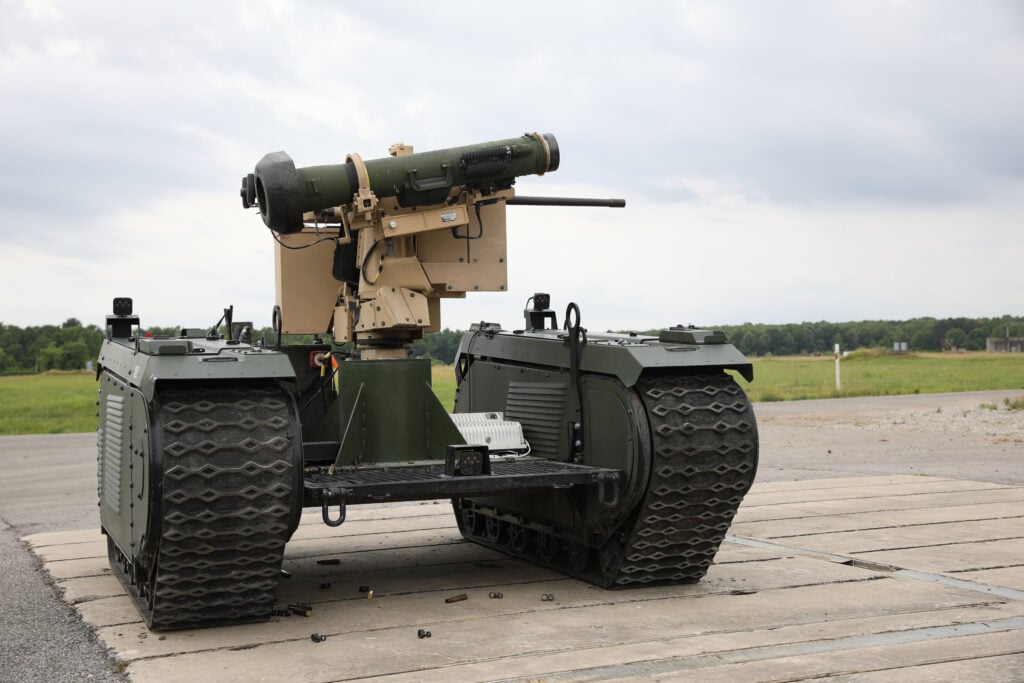
QinetiQ Titan robot fitted with a Javelin anti-tank missile launcher
400 Players, 100 Capabilities, 13 Days
Unified Challenge was a massive and expensive endeavor that took a year of planning. The final report is due to Lt. Gen. Eric Wesley, Army Futures Command’s chief of concepts, by the end of November. Unified Challenge was so labor-intensive, in fact, that Col. Bailey said the Army isn’t currently planning any further wargames with so many human players and so much detailed simulation, instead turning to a series of smaller and more focused experiments.
August’s two weeks of wargaming, plus a week of prep time for participants, involved 400 human players — mostly Army but with a significant contingent from the Air Force — at 13 locations across the country. The humans took on the roles of commanders and staffs at the division, brigade, battalion, and company level, directing over 16,000 simulated soldiers — four brigades — whose weapons and vehicles were modeled in detail.
All told, the wargame modeled about 100 specific capabilities. (That was pruned down from an initial wishlist of 150). While many details are classified, I was able to confirm the following high-priority future systems were included:
- Robotic Combat Vehicles (RCV), various types of remote-controlled mini-tanks and other unmanned vehicles acting as expendable auxiliaries to traditional armored vehicles. (The Army’s also working on a larger Optionally Manned Fighting Vehicle, but that wasn’t included in this simulation).
- The Future Attack Reconnaissance Aircraft (FARA), a high-speed scout to fill the hole left in Army squadrons by the retirement of the OH-58 Kiowa. (The Army’s other Future Vertical Lift aircraft, the Future Long-Range Assault Aircraft to replace the UH-60 Black Hawk, was not featured in the wargame).
- Extended Range Cannon Artillery (ERCA), a modification to the existing M109 Paladin howitzer that, combined with new kinds of rocket-boosted ammunition, could more than double range, from under 20 miles to more than 40. (Interestingly, long-range missiles don’t seem to have been included in the wargame, perhaps because they are likely to be controlled by corps headquarters that were outside the scope of this single-division simulation).
- The drone-borne Multi-Function Electronic Warfare (MFEW)- Air jamming system and its truck-mounted counterpart, the Terrestrial Layer System (TLS), which can detect and disrupt enemy communications over long distances.
The simulation was sufficiently detailed, the Army briefers said, to output reports on exactly how many rounds were fired and how much fuel had to be provided.
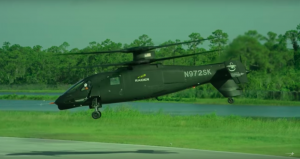
Sikorsky’s S-97 Raider, a leading candidate for the Future Attack Reconnaissance Aircraft, shows off its agility.
The Army wouldn’t divulge the scenario, but we can make some guesses. Without Navy or Marine Corps participation, the simulated war zone was unlikely to be the Pacific, where land forces would play a supporting role in a conflict with China. The Pentagon’s other big problem, and a bigger focus for the Army, is Russia, which would be fought largely on land and in the airspace above it. (In Europe, naval forces would largely operate on the perimeter, say in Norway, and any ships in the narrow, shallow Baltic Sea might not survive the opening salvos). A stray remark by one briefer that the simulated combat zone was cramped — “this a pretty tight area to operate in” — strongly suggests the Baltic States, the tiny NATO allies pressed up against the Russian border.
For all this detail, however, there was one major omission: morale. While a “will to fight” model is in development, it wasn’t ready for Unified Challenge, and determining when troops are likely to break from casualties, exhaustion, or shock is highly subjective. So the simulated troops performed far more consistently than real humans do in combat.
That said, Unified Challenge did go a long way to replicate the stress, confusion, and adrenaline at command posts as the human players directed their virtual forces for two weeks of warfare. It’s the complexity at those command posts which the wargame really was wrestling with — and which will prove a daunting challenge in the future.
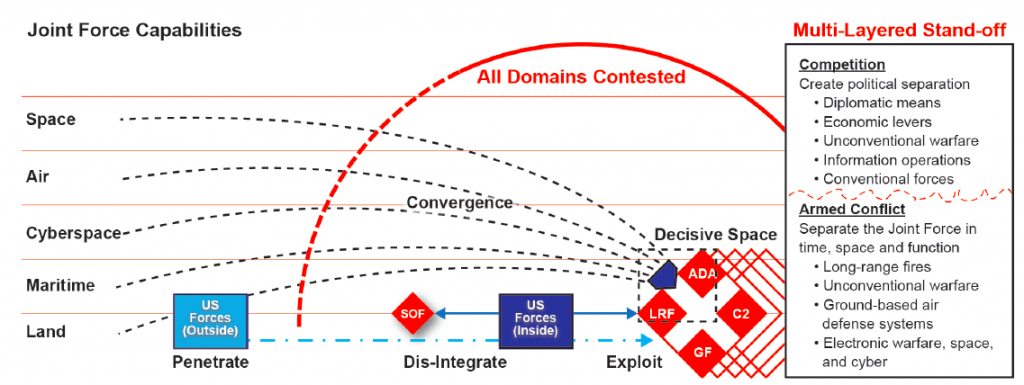
SOURCE: Army Multi-Domain Operations Concept, December 2018.
The Hard Part
Why is the new concept, Multi-Domain Operations, so complicated to command and control? To understand the future, you need to understand the past.
For decades, US military planners have used a rigidly step-by-step approach to reduce the chaos of conflict to manageable tasks. First, US forces deploy by train, truck, plane and ship. Then Air Force, Navy, and Marine Corps airpower decimates enemy defenses. Finally, ground troops roll in. US forces are assumed to have unlimited access to the sea, the air, the electromagnetic spectrum, and cyberspace, allowing them to move forces, supplies and data unopposed.
That model held in Afghanistan and Iraq, but a high-tech major power like Russia or China would be able to oppose the US in all of those domains. After years of study and soul-searching, the Army and the Air Force decided the best way to fight back was to fight in all domains at once. (The Navy and Marines remain skeptical). Instead of the rigid old-school sequence, the US would simultaneously attack via land, sea, air, space, cyberspace, and the electromagnetic spectrum.
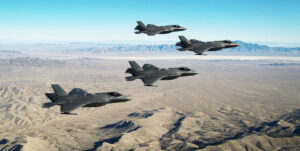
F-35As
But such a symphony of violence is extremely complicated to coordinate. For example, the traditional system would divide up the map, leaving distant areas for Air Force strikes while reserving targets closer to the frontline for Army artillery. But in Multi-Domain Operations, what forces can hit what targets may change moment to moment. Hacking or jamming an enemy radar, for instance, might briefly open a corridor for aircraft, only to have it close again as the enemy adapts.
So how do you decide, in each fleeting instance, whether to use an F-35, the Army’s new long-range artillery, or something entirely different, say a cyber attack that can shut down the enemy without risking American lives? Before you can make that decision, how do you combine the data from all your different forces — satellites, fighters, drones, ground robots, human soldiers with AI-assisted goggles — to form a single coherent picture of what’s happening? And how do you share that picture when enemy hacking and jamming may cut your communications to any given unit at any time?
Cyber and electronic warfare proved a vital tool in this wargame. “If you’re not dominating the electromagnetic spectrum, [at least] in places… then you’re going to have a very difficult time,” Bailey said. But these so-called non-lethal or non-kinetic “effects” weren’t necessarily decisive at the down-and-dirty tactical level of the brigade. Old-fashioned physical fighting is still essential.
So is old-fashioned initiative. Micromanaging your far-flung subordinates or asking your superior “mother, may I?” becomes impossible when communications can be cut off at any time. That puts a premium on what the Army calls “mission command,” in which superiors give subordinates a clear objective but also provide wide discretion in how to achieve it. Mission command “becomes even more important on the future battlefield…when you can have a brigade operating on its own without communications with higher echelons,” Cassibry said.
The challenge is creating a command-and-control system that can intelligibly display all the data that pours in when the network is working — but then keep on fighting when that digital eye goes blind.
Edited 11:15 am to clarify what specific kinds of wargames the Army was not planning to hold more of.





















